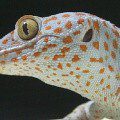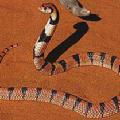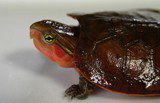
big-headed turtle
The big-headed tortoise lives in the territories of Laos and Cambodia, Burma, the Indochinese Peninsula, southern Myanmar and northern Thailand. It is located in transparent and fast rocky streams and rivers. During the day, it basks in the sun, near water or hides in shelters. Goes hunting at dusk.
She has a small size – a shell about 18 cm long. At the same time, she has a very large head, which is covered with one extensive, durable shield and, due to its size, does not retract under the shell. She has a strongly flattened shell, which is why her legs and long tail are not completely retracted inside.
The large-headed tortoise obtains food for itself both in water and on land. Eats small fish, invertebrates, duckweed. At home, from plants, he prefers cabbage and lettuce, loves fruits – bananas and mangoes. Mating takes place throughout the year, the turtle lays two eggs in the clutch.
The big-headed turtle adapts well to life in captivity – it can live for more than 20 years.
This species is listed in the International Red Book.
Additionally
In Southeast Asia, large-headed turtles are actively eaten – as a result, the population is greatly reduced.
This species is listed in the International Red Book.
Food
 The large-headed tortoise obtains food for itself both on land and in water. It feeds on mollusks, small fish, worms and other invertebrates.
The large-headed tortoise obtains food for itself both on land and in water. It feeds on mollusks, small fish, worms and other invertebrates.
From plants prefers duckweed, at home – lettuce, cabbage.
From fruit likes bananas and mangoes.
Reproduction
Mating occurs in all seasons, but peak activity occurs between February and May. Laying is done between July and September. Large-headed turtle females lay two eggs each.
Content
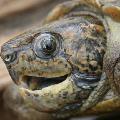 Freshwater turtles are kept in aquaterrariums, the size of which directly depends on the size of the turtle itself. For a large-headed turtle, an aquaterrarium for 150-200 liters of water will be enough. It should be borne in mind that the water level in the aquaterrarium should be about 10-20 cm below the edge. This will not allow the turtle to get out of it. It will also be necessary to cover the aquaterrarium with a well-secured mesh cover – this is another mandatory measure to prevent the escape of the turtle.
Freshwater turtles are kept in aquaterrariums, the size of which directly depends on the size of the turtle itself. For a large-headed turtle, an aquaterrarium for 150-200 liters of water will be enough. It should be borne in mind that the water level in the aquaterrarium should be about 10-20 cm below the edge. This will not allow the turtle to get out of it. It will also be necessary to cover the aquaterrarium with a well-secured mesh cover – this is another mandatory measure to prevent the escape of the turtle.
This turtle does well in captivity and can live 20 years or more.
Very active, can easily climb over wire fences, climbing out of a low aquaterrarium. And although it usually remains cautious and shy, some individuals can get used to a person.
The terrarium will require the reconstruction of a biotope model (habitat) of the large-headed turtle.
An indoor aquaterrarium is required to keep this species. The average air temperature in the daytime should be 26-30 degrees, in the evening from 18 to 22 degrees, water temperature 20-25. To maintain the temperature within the required limits, a water heater, a 25-40 W incandescent lamp, and a filter will be required for clean water.
The bottom of the reservoir will need to be equipped with stones and snags that will protrude above the surface. You will also need to make shelters with wide entrances and exits so that the turtle cannot get stuck.
Recently, more and more terrariumists refuse artificial ones in favor of living plants. Without a doubt, plastic imitations have a lot of advantages: they do not require maintenance, it will be problematic for the animal to damage them, they are quite easy to wash and disinfect. However, for terrariumists who seek to show their individuality, plastic duplicates are not suitable – the containers they have designed become similar to each other like two drops of water. Therefore, they exchange them with great pleasure for real, living plants.
High-quality water filtration in a terrarium is a necessary thing. Its essence is to remove the waste products of animals that live in this terrarium – metabolites – dissolved in water. Filtration is carried out in four stages:
1. Biological treatment, which is the main means of purifying water from toxic substances that are formed during the life of a turtle;
2. Mechanical cleaning, which ensures the removal of particles from the water that are in suspension. Also, this purification ensures the transparency of water;
3. Physical adsorption – during this process, dissolved organic substances that have passed through the filter are deposited;
4. And the final stage is disinfection. During this process, microorganisms that float freely in the water are destroyed.
The soil in the terrarium is also not unimportant. It helps to improve the hygienic state of the terrarium, including absorbing liquid feces. The most optimal soil for amphibians is fresh earth. The main factor in favor of its use is its biological activity. In this regard, it is necessary to lay only fresh soil in the terrarium initially. Once dried, the earth can restore part of the microflora when moistened, however, its composition will already be much poorer, which will naturally reduce its biological activity.
The big-headed turtle requires special water cooling in the aquarium. The scheme of the cooling system is quite simple. In the aquarium part of the aquaterrarium, between the vertical filter cassettes or under the bottom filter substrate, a cold unit evaporator coil is installed. The coil will need to be made from materials that are resistant to water, such as stainless steel. Its area depends on the difference between the ambient temperature and the required water temperature, as well as on the power of the refrigeration unit.
For the Burmese subspecies, more stringent conditions will be required: it will be necessary to create an imitation of a mountain stream with running water, with a temperature of 12 to 20 degrees and thorough filtration.
In captivity, these turtles most of all prefer to eat pieces of fish, newborn mice, and frog meat.
At one terrarium owner, a large-headed turtle, when it felt hungry, began to loudly knock its head against the glass of the outer wall of the aquaterrarium, demanding to be fed. As soon as she stretched out food, she immediately swallowed it.
Another zoologist tested the turtle by showing it a mirror. His reflection made the turtle furious, and he tried to bite, throwing himself at his reflection with force.
Other names
Platysternon megacephalum
Subspecies
Platysternon megacephalum megacephalum
Platysternon megacephalum peguense (Burmese bighead)
Platysternon megacephalum shiui (Vietnamese bighead)
Platysternon megacephalum tristernalis (Yunnan Big-Headed Turtle)
Platysternon megacephalum vogeli (Thai bighead)
Inhabitation
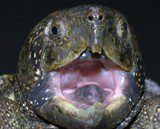 This turtle is distributed in the territories of Burma, Laos and Cambodia, South China, Hainan Island, the Indochinese Peninsula, northern Thailand and southern Myanmar. She prefers fast and transparent rocky streams and rivers among mountain forests.
This turtle is distributed in the territories of Burma, Laos and Cambodia, South China, Hainan Island, the Indochinese Peninsula, northern Thailand and southern Myanmar. She prefers fast and transparent rocky streams and rivers among mountain forests.
In the daytime, the big-headed turtle basks in the sun almost at the water’s edge or hides under the rocks. It only hunts at dusk.
Description
The big-headed tortoise is the only representative of the family of the same name. She has a very unique appearance.
The turtle itself is relatively small in size – its shell is about 18 cm long. At the same time, it has a disproportionately large head, which is covered on top with one strong large shield. It has a mobile and long neck, however, due to its size, the head is not retracted under the shell. The upper jaw has a pointed downward beak.
Large and wide, loosely spaced scales cover the heels, forearms and shins of the turtle, the rest of the neck and legs are covered with grain-like scales. As for the throat, it is covered with flat and round warts in the big-headed turtle.
The upper parts of the turtle’s body are olive-brown in color, the lower parts of the body are light yellow-brown, the tail and lower legs are covered with reddish irregular spots, and a black stripe runs along the eye.
The big-headed tortoise has a flattened shell, which is why the very long tail and legs cannot completely retract inside. Therefore, both the tail and the outer parts of the legs have their own additional protection – large horny shields. On the fingers are strong short claws. The front legs are armed with five claws, the hind legs with four, which are interconnected by weakly developed swimming membranes.
The subspecies megacephalum megacephalum has no pattern on the plastron, it is yellow in color. Carapace with poorly developed growth zones on scutes, slightly keeled, with slightly serrated posterior margin. Well-developed head shields hang over the eyes. Edge shields hang over the jumper. There are yellow spots on the jaws. Narrow radial lines are located on the top of the head.
The Burmese subspecies has well-developed annual rings. Seams located on the plastron of a dark shade. The keel is clearly expressed on the carapace, it happens that the lateral keels are also determined. The posterior edge of the carapace is serrated. The jaw of representatives of this subspecies without a pattern, hooked. Behind the eye there is a stripe with a black border.
The Thai subspecies has no pattern on the plastron, it is yellow in color. The edges of the carapace are not jagged, the carapace itself is smooth to the touch. The upper jaw is narrow, short and not as hooked.
In the subspecies megacephalum tristernalis, three small additional scutes are noted at the medial junction of the shoulder and throat scutes of the plastron.
The Vietnamese subspecies has a smooth carapace, without serrations along the posterior margin. The carapace, ventral side of the tail, limbs and head are covered with a large number of spots of orange, yellow and pink. Head shields in turtles of this subspecies are moderately developed, do not hang over the eyes. The upper jaw is slightly hooked.
She is a good swimmer, rather dexterously moves along rocky rapids and banks, and can climb the trunks of inclined trees.
Sources of
http://www.floranimal.ru
http://www.cherepahi.ru
http://ru.wikipedia.org
http://ours-nature.ru




